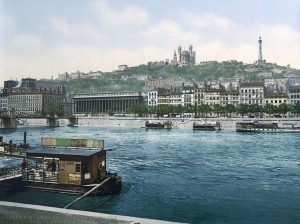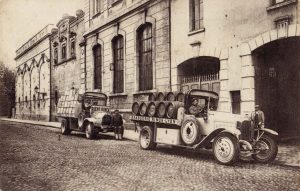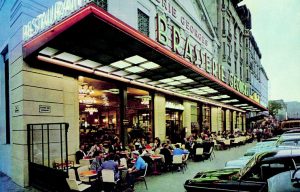Lyon: a brewing island in a sea of wine
 One of the subjects I love writing about, is the beer history of France. You mean, they have a beer history? They do, because besides all the wine there are also the extreme north (French Flanders and Picardy) and the east (Alsace), that both have a tradition of brewing. For centuries, even Paris had a brewers’ guild. And there was another place that I encountered from time to time: Lyon. Europe’s southernmost traditional brewing city.
One of the subjects I love writing about, is the beer history of France. You mean, they have a beer history? They do, because besides all the wine there are also the extreme north (French Flanders and Picardy) and the east (Alsace), that both have a tradition of brewing. For centuries, even Paris had a brewers’ guild. And there was another place that I encountered from time to time: Lyon. Europe’s southernmost traditional brewing city.
I’m from Holland, and most of my fellow countrymen only know Lyon as that big city you pass on your way to your holiday address in the Ardèche or Provence. You either drive by really fast or spend hours in a traffic jam in the infamous Fourvière tunnel. Not a lot of people know that it’s actually a great place to visit. There are culinary highlights, funny trompe-l’oeil murals, Roman ruins and in December there’s the famous Festival of Lights. Another fun thing to explore are the ‘traboules’: small alleys hidden behind inconspicuous front doors in the main streets. You are actually allowed to enter, and you walk out on the other end, into a different street. It turns a simple stroll into an exploration!
 Situated between the Côtes-du-Rhône and Beaujolais regions, you’d expect wine to be the staple drink here. Yet, for a long time Lyon has known a tradition of brewing. In the 19th century, ‘bière de Lyon’ was its own beer type, and as such was described in various brewing manuals. Luckily, this time I didn’t have to do all the research to find out more: in 2016, a guy called Romain Thinon finished his thesis, consisting of 1499 pages (!) on this very subject. And especially for you, I have worked my way through it.
Situated between the Côtes-du-Rhône and Beaujolais regions, you’d expect wine to be the staple drink here. Yet, for a long time Lyon has known a tradition of brewing. In the 19th century, ‘bière de Lyon’ was its own beer type, and as such was described in various brewing manuals. Luckily, this time I didn’t have to do all the research to find out more: in 2016, a guy called Romain Thinon finished his thesis, consisting of 1499 pages (!) on this very subject. And especially for you, I have worked my way through it.
In many regions of Europe, beer was and is the people’s drink: relatively cheap and drunk by all layers of society. This was also the case in Northern France and Alsace. Less so in Lyon. There, the popular drink was, as one might expect, wine. In the 19th century, inhabitants of Lyon drank about 150 to 200 litres of wine a year, while in 1850 they only drank 20 litres of beer. As a comparison, in 1857 that figure was at 187 litres of beer in Lille and 110 litres in Strasbourg. (And to give you an idea, in Holland and Belgium this is currently about 70 litres.)[1]
 Still, Lyon really was a ‘brewing island in a sea of wine’: in the rest of southern France, and especially in the countryside, beer consumption was close to zero. That Lyon drank at least some beer, had breweries and even its own beer type, was remarkable. Even more so because it wasn’t made from local or regional ingredients. There was almost no barley grown there, and no hops whatsoever. Even though 200 km to the north, in the Dijon area, there was quite a lot of hop culture, Lyon imported most of its hops from Germany and Bohemia. It explains why beer was relatively expensive there compared to wine. In Lyon, beer was a drink of luxury, for higher middle class people who fancied something else for a change.
Still, Lyon really was a ‘brewing island in a sea of wine’: in the rest of southern France, and especially in the countryside, beer consumption was close to zero. That Lyon drank at least some beer, had breweries and even its own beer type, was remarkable. Even more so because it wasn’t made from local or regional ingredients. There was almost no barley grown there, and no hops whatsoever. Even though 200 km to the north, in the Dijon area, there was quite a lot of hop culture, Lyon imported most of its hops from Germany and Bohemia. It explains why beer was relatively expensive there compared to wine. In Lyon, beer was a drink of luxury, for higher middle class people who fancied something else for a change.
As said, in the 19th century ‘bière de Lyon’ was a beer type of its own. French brewing engineer Georges Lacambre gave a description of it in 1851:[2]
- It was brewed year-round (except in extreme heat)
- For one hectolitre of beer, one needed 36 to 38 kg of lightly amber malt, 500 grams of good German hops and 35 ml of yeast
- Like the beer of Paris and Lille, it was boiled for 8 to 10 hours, and fermented for 3 to 4 days
- It contained 5% to 6.4% ABV
- It was dark amber in colour, had a very agreeable taste, it was mellow, strong and hoppy
- In Lyon, it was drunk four to five weeks after brewing
- The export variety was brewed only in winter and drunk only after four to five months (like the bière de garde of Strasbourg, Lille and Paris).
Lyon had become a brewing city relatively late. Only during the 18th century, the brewing scene there was developed by immigrants from Germany. They seized upon an opportunity, in a big city strategically located on waterways. In the 19th century, new brewers joined them, some of which were from Alsace. All this may explain the use of German hops. All in all, the beer of Lyon was a lot more Germanic than you would expect!
At first, the breweries of Lyon were small and artisanal. From about ten of them at the beginning of the 19th century, the number of breweries rose to an all-time high of about 27 in the year 1867. At the same time, the city grew (it had almost 300,000 inhabitants in 1850) and so did the per capita consumption of beer: all that meant plenty of customers.[3] Furthermore, Lyon exported a lot of its beer: in 1839, no less than 44% of production left the Rhône department. It was shipped all over southern France but also abroad, to Switzerland and even Greece.[4]
 The success story didn’t last. In the second half of the 19th century, France went wild for German-style bottom-fermented beer, mostly in the form of blonde, foaming and crystal clear bock beer. The brewing sector industrialised and concentrated. For the brewers of Lyon, there was no choice but to go along with this trend. Worse, all over southern France breweries popped up, most of them very modern ones, founded by Alsatian brewers. Lyon once had the southern market to itself, now there were small ‘brewing islets’ everywhere. At the same time, beer consumption in Lyon went down again. You might expect that the crisis in the wine sector (in the late 19th century, the ever-hungry Phylloxera bug destroyed vineyard after vineyard) would have boosted beer sales, but it didn’t.
The success story didn’t last. In the second half of the 19th century, France went wild for German-style bottom-fermented beer, mostly in the form of blonde, foaming and crystal clear bock beer. The brewing sector industrialised and concentrated. For the brewers of Lyon, there was no choice but to go along with this trend. Worse, all over southern France breweries popped up, most of them very modern ones, founded by Alsatian brewers. Lyon once had the southern market to itself, now there were small ‘brewing islets’ everywhere. At the same time, beer consumption in Lyon went down again. You might expect that the crisis in the wine sector (in the late 19th century, the ever-hungry Phylloxera bug destroyed vineyard after vineyard) would have boosted beer sales, but it didn’t.
By 1894, only six breweries were left in Lyon, of which only one still made the traditional ‘bière brune de Lyon’.[5] The city had gone down the lager road for good, and as such had lost its former status of beer city. The last brewery, Rinck, closed its doors in 1970.[6]
 And yet… a few remnants of Lyon’s beer history have survived. The popular Ninkasi brewery, founded in 1997, makes a porter inspired by the 19th century brown beer. Even more fun is the venerable Brasserie Georges, located in an eye-catching art deco building on Cours de Verdun Perrache. At first sight it’s just a chic restaurant, that has counted Jacques Brel, Edith Piaf, Jules Verne, Ernest Hemingway and Auguste Rodin among its customers. A restaurant that holds the world record for the biggest sauerkraut (8 meters in length). But in French, ‘brasserie’ actually means ‘brewery’, and that’s what ‘La Georges’ once was. In 1836, one Georges Hoffherr, from Alsace, started the company as a brewery, but slowly serving food became the main activity. Beer production there ceased in 1939, but… in 2004 the restaurant once more started brewing its own beer. Which, of course, closes the circle. Lyon’s oldest surviving brewery is brewing again.[7]
And yet… a few remnants of Lyon’s beer history have survived. The popular Ninkasi brewery, founded in 1997, makes a porter inspired by the 19th century brown beer. Even more fun is the venerable Brasserie Georges, located in an eye-catching art deco building on Cours de Verdun Perrache. At first sight it’s just a chic restaurant, that has counted Jacques Brel, Edith Piaf, Jules Verne, Ernest Hemingway and Auguste Rodin among its customers. A restaurant that holds the world record for the biggest sauerkraut (8 meters in length). But in French, ‘brasserie’ actually means ‘brewery’, and that’s what ‘La Georges’ once was. In 1836, one Georges Hoffherr, from Alsace, started the company as a brewery, but slowly serving food became the main activity. Beer production there ceased in 1939, but… in 2004 the restaurant once more started brewing its own beer. Which, of course, closes the circle. Lyon’s oldest surviving brewery is brewing again.[7]
[1] Romain Thinon, Un îlot brassicole. Brasseurs et brasseries à Lyon et dans le Rhône (fin XVIIIe siècle – 1914), Lyon 2016, p. 74, 161.
[2] Georges Lacambre, Traité complet de la fabrication de bières et de la distillation des grains, pommes de terre, vins, betteraves, mélasses, etc., Brussels 1851, p. 301; Thinon, Un îlot brassicole, p. 171.
[3] Thinon, Un îlot brassicole, p. 73, 585.
[4] Thinon, Un îlot brassicole, p. 178-191.
[5] Thinon, Un îlot brassicole, p. 207.
[6] https://www.leprogres.fr/lyon/2015/11/01/l-histoire-oubliee-des-grandes-brasseries-lyonnaises
[7] With many thanks to Christophe Boebion who tipped me off about Romain Thinon’s thesis.






Leave a Reply